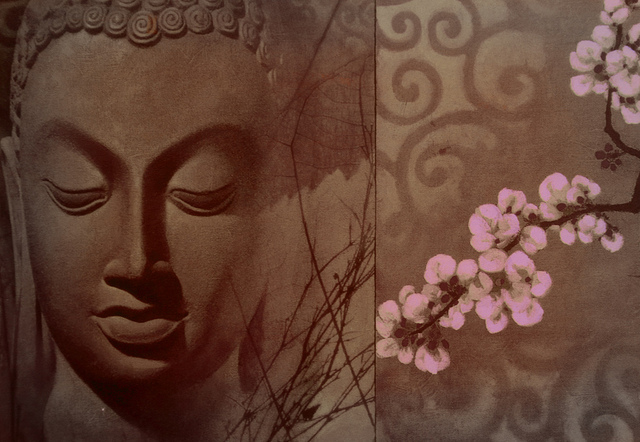
According to Buddhist teachings—passion, affection, and sensual desire cause us suffering, yet many of us believe that all of these are core qualities within love.
Buddhists teach that passion infuses desire, anger, and ignorance, which causes us sorrow and fear.
Desire gives us an endless thirst for what we haven’t got, and it keeps us in a state of continual longing. We don’t feel fulfilled or satisfied. Anger occurs when the desires we think we deserve are denied. Ignorance consists of resentment, venom, and envy for those who we feel are more fortunate than we are.
Affection is seeped in the need for reciprocity and craving. When we are openly affectionate with someone, we may then expect that person to be mutually affectionate with us—and when that expectation does not materialize, we can be left feeling hurt, abandoned, rejected, and confused.
Seeking temporary pleasure is a distraction from stress or suffering, and when the effect of receiving the pleasure wears off, we create more desires and longings and remain in this perpetual cycle of ignoring the underlying reasons for them.
Buddhism encourages four forms of love, called the four Brahmaviharas: loving-kindness (metta), compassion (karuna), sympathetic joy (mudita), and equanimity (upekkha).
The reason these four are essential qualities of love in Buddhist traditions is because they are warm, tender, and sympathetic notions of love that radiate from the heart center, inclusive of our selves and of others.
The Buddha (and those who follow Buddhism) do not seek to be loved; they embody love, and in doing so, they become the essence of love. They do not feel a need to prove to others how deep or strong their love is or to express it in ways that gain approval or validation. Rather, they radiate love from their hearts and minds, and the peacefulness that ensues is visible for all to feel and see.
It could appear that passion is not a valued in Buddhism, however, this only depends upon what we perceive passion to be. The Dalai Lama is enthusiastic, motivated, full of vitality, and devoted to his work—therefore, it could be said that he is a passionate man who is excited about life and who has a strong commitment to his role.
The reason the Dalai Lama seems so contented and harmonious is because he relinquishes attachments and expectations; therefore, he does not suffer for what he loves, but he simply remains rooted and present in the moment, fully connected to himself and all that exists around him. He does not look to the past or lament over what he no longer has, nor does he stretch his imagination far off into the future and stress himself out worrying what might lie ahead.
Buddhist teachings explain that when we are free from yearnings, cravings, desires, and expectations, then we open ourselves up to tranquility, calm, peace, tenderness, empathy, compassion, contentment, and joy.
When feeling any of the latter emotions, we are then in a healthy, balanced state of heart and mind to love completely and without any suffering. Therefore, we don’t need to fall in and out of fleeting love. We can continuously remain in a state of love in the present moment.
Buddhism is not about denying our emotions; rather, it is about understanding how certain emotions have the ability to garner control over us and (ironically) result in denying us the very things we hope to achieve.
The Indian word “raga” is often translated as passion—and the Buddha is often referred to as being araga, which means raga-free, or free from passion. However, instead of araga meaning free from all emotion, the meaning of it is to be liberated from the emotions that are causing unnecessary suffering and to be fueled with the emotions that bring about peacefulness and the purest form of love.
Many people want to love and to be loved so desperately that the emotions and feelings that arise through this desire are ones that cause us suffering, disconnect from love, and prevent a healthy and stable connection from developing.
When we want something intensively, our emotions jump in to block and deflect it. This is all occurring at such a deep, subconscious level that many people are wholly unaware of it.
When we become aware of emotions erupting inside of us that could lead us to suffering and disharmony, we do not need to feel guilt or shame for the way we are feeling, as all of our emotions are a natural part of being human. Instead, we can allow the emotion to play out, without allowing it to manipulate and control us.
Rather than suppressing our desires, cravings and longings, we can let the emotions live and breathe without acting on them. This is known as renunciation—releasing our attachment to cravings and desires that keep us trapped in a cycle of pain and bind us to suffering, not permanent happiness and satisfaction like we may have hoped and believed.
When we relinquish our attachments, we release suffering at the same time.
Through regular meditation and learning to exist in the present moment, we can reduce the temptation to act on the emotions that cause us suffering. The more often we practice, the less intense these emotions become.
There is no set rule to practicing renunciation as a layman—therefore, we do not need to give up any of our daily pleasures. Instead, we can simply become aware of our attachment to them and recognize how they ultimately cause us to suffer.
In doing this, we will naturally ease our suffering. When we have control over our emotions, rather than our emotions controlling us, we will not be blindly led to act in ways that result in a pattern of pain.
Dispassion is enjoying what brings us pleasure, without being under the illusion that the joy and pleasure will last forever.
~
Author: Alex Myles
Image: Flickr/Sigi K ॐ
Editor: Yoli Ramazzina
Copy editor: Lieselle Davidson
Social editor: Callie Rushton






Read 1 comment and reply